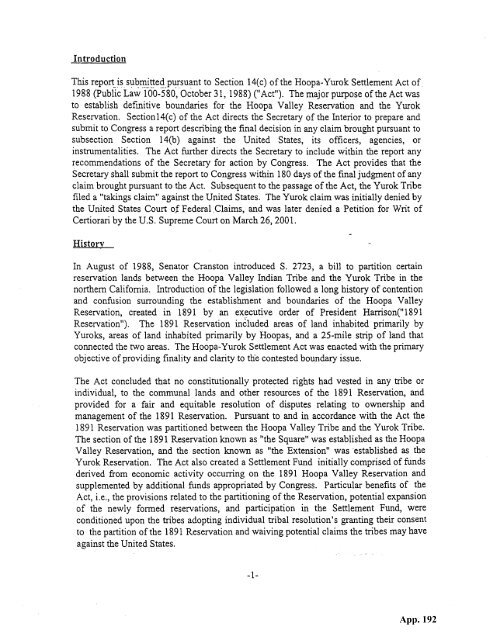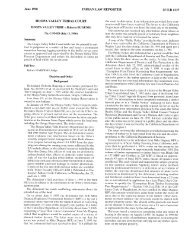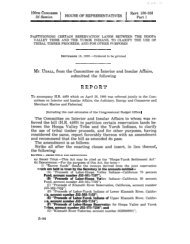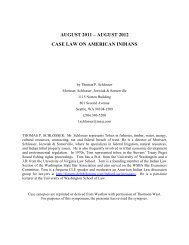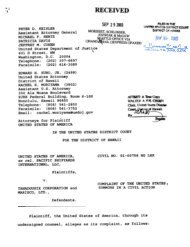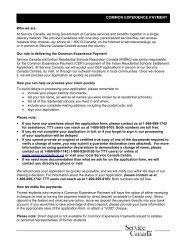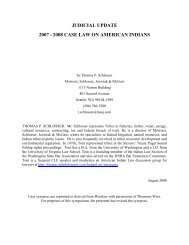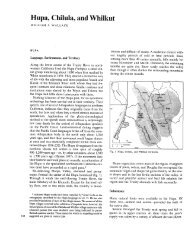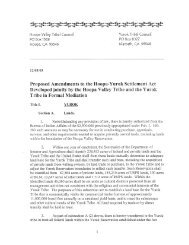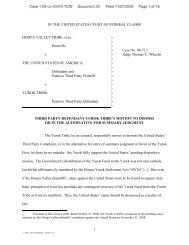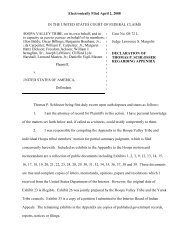Hoopa appendix supporting summary judgment - Schlosser Law Files
Hoopa appendix supporting summary judgment - Schlosser Law Files
Hoopa appendix supporting summary judgment - Schlosser Law Files
Create successful ePaper yourself
Turn your PDF publications into a flip-book with our unique Google optimized e-Paper software.
Introduction<br />
This report is submitted pursuant to Section 14(c) of the <strong>Hoopa</strong>-Yurok Settlement Act of.<br />
1988 (Public <strong>Law</strong> 100-580, October 31, 1988) (“Act”). The major purpose ofthe Act was<br />
to establish definitive boundaries for the <strong>Hoopa</strong> Valley Reservation and the Yurok<br />
Reservation. Section 14(c) of the Act directs the Secretary of the Interior to prepare and<br />
submit to Congress a report describing the final decision in any claim brought pursuant to<br />
subsection Section 14(b) against the United States, its officers, agencies, or<br />
instrumentalities. The Act further directs the Secretary to include within the report any<br />
recommendations of the Secretary for action by Congress. The Act provides that the<br />
Secretary shall submit the report to Congress within 180 days of the final <strong>judgment</strong> of any<br />
claim brought pursuant to the Act. Subsequent to the passage ofthe Act, the Yurok Tribe<br />
filed a “takings claim” against the United States. The Yurok claim was initially denied by<br />
the United States Court of Federal Claims, and was later denied a Petition for Writ of<br />
Certiorari by the U.S. Supreme Court on March 26, 2001.<br />
History -<br />
In August of 1988, Senator Cranston introduced S. 2723, a bill to partition certain<br />
reservation lands between the <strong>Hoopa</strong> Valley Indian Tribe and the Yurok Tribe in the<br />
northern California. Introduction of the legislation followed a long history of contention<br />
and confusion surrounding the establishment and boundaries of the <strong>Hoopa</strong> Valley<br />
Reservation, created in 1891 by an executive order of President Harrison(”1891<br />
Reservation”). The 1891 Reservation in~1udedareas of land inhabited primarily by<br />
Yuroks, areas of land inhabited primarily by <strong>Hoopa</strong>s, and a 25-mile strip of land that<br />
connected the two areas. The <strong>Hoopa</strong>-Yurok Settlement Act was enacted with the primary<br />
objective of providing finality and clarity to the contested boundary issue.<br />
The Act concluded that no constitutionally protected rights had vested in any tribe or<br />
individual, to the communal lands and other resources of the 1891 Reservation, and<br />
provided for a fair and equitable resolution of disputes relating to ownership and<br />
management of the 1891 Reservation. Pursuant to and in accordance with the Act the<br />
1891 Reservation was partitioned between the <strong>Hoopa</strong> Valley Tribe and the Yurok Tribe.<br />
The section of the 1891 Reservation known as “the Square” was established as the <strong>Hoopa</strong><br />
Valley Reservation, and the section known as “the Extension” was established as the<br />
Yurok Reservation. The Act also created a Settlement Fund initially comprised of funds<br />
derived from economic activity occurring on the 1891 <strong>Hoopa</strong> Valley Reservation and<br />
supplemented by additional funds appropriated by Congress. Particular benefits of the<br />
Act, i.e., the provisions related to the partitioning of the Reservation, potential expansion<br />
of the newly formed reservations, and participation in the Settlement Fund, were<br />
conditioned upon the tribes adopting individual tribal resolution’s granting their consent<br />
to the partition ofthe 1891 Reservation and waiving potential claims the tribes may have<br />
against the United States.<br />
—1—


